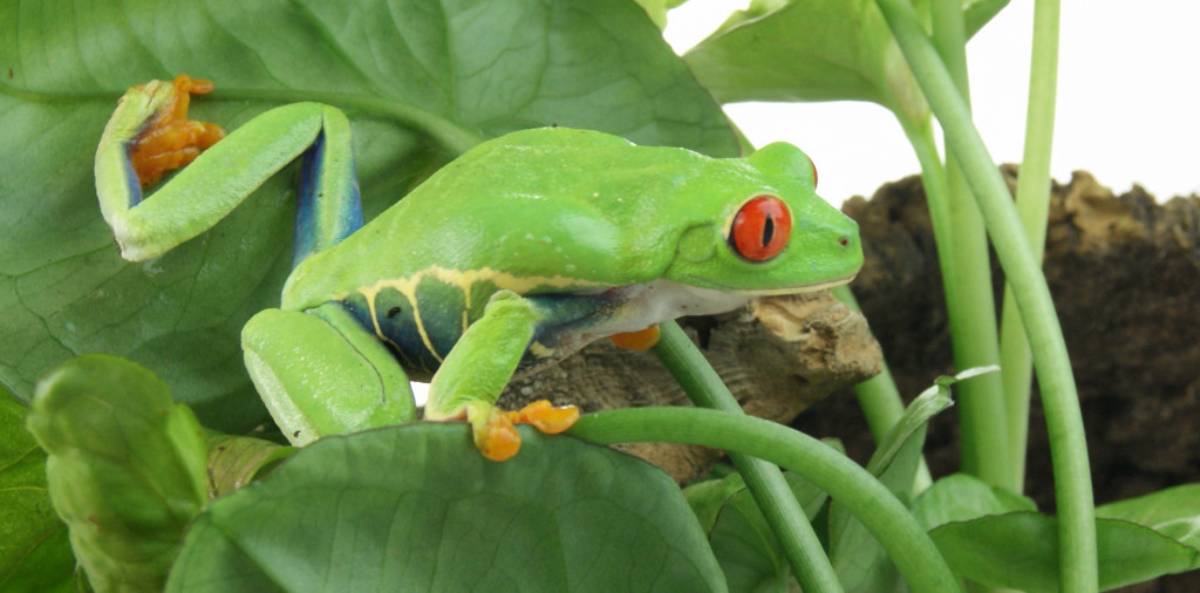Josh's Frogs
Picking the Perfect Plants: Artificial vs Real Plants
Not sure if artificial or real plants are the best for you (and your pets)? Read this helpful blog by the pros at Josh's Frogs and find out what plants are best for you!

Imagine you're getting ready to set up a habitat for a new pet. You know you want the enclosure to look nice, but you're unsure if you should use real plants, or stick with artificial foliage. Which one is right for you and your herp? This article from Josh's Frogs will help you make an educated decision, and weigh the benefits (and drawbacks) of using artificial or live plants in your reptile or amphibian enclosure.
The Benefits of Artificial Plants
Sometimes viewed as tacky or simply fake looking, artificial plants do have a few benefits over live plants when it comes to their use in a terrarium. Artificial plants are easy to clean and disinfect. With the vast majority of fake plants made of fabric or plastic, a quick 5 minute soak in a 5% bleach/water solution followed by a rinse with water and air drying is enough to keep your plants clean.
Real plants can be cleaned in the event that your pet reptile or amphibian becomes ill and it's habitat requires a tear down and complete disinfection, but cleaning real plants is much more difficult, and many times the plants do not tolerate the same kind of cleaning processes recommended for artificial plants.
With artificial plants, there is virtually no additional action required to keep them looking good than the occasional cleaning. Real plants will require regular watering and trimming. Additionally, you should always be on the lookout for signs that your live terrarium plants are not faring well or have come down with a plant pest. For those of you that do not have a green thumb, artificial plants may be the easy-to-keep choice you're after to spice up your pet's enclosure.
Artificial terrarium plants can be used in virtually any setup. Being that they are not alive, artificial plants do not share the specialized vivarium lighting, naturalistic vivarium substrate, or watering requirements that live terrarium plants do. While an enclosure containing fake plants can be constructed completely with the animal inhabitant's needs in mind, a vivarium containing both live plants and animals must take the needs of all living organisms into consideration in order to be successful.
The Benefits of Real Plants
 Often thought of as a challenge to keep or not worth the trouble if they can be avoided, live terrarium plants can serve several important functions in a properly designed vivarium.
Often thought of as a challenge to keep or not worth the trouble if they can be avoided, live terrarium plants can serve several important functions in a properly designed vivarium.
Real plants aid in maintaining a higher level of humidity in the vivarium. Plants require water and soil to grow in—moist soil and plant respiration will put water back into the air, creating a humid microclimate in your pet's enclosure. For many reptiles and amphibians, humidity is vital for proper shedding, and is absolutely necessary for normal function to those animals from non-arid regions. Artificial plants do not significantly contribute to the humidity levels in a terrarium, short of when they are misted directly.
Live terrarium plants utilize animal waste and excess nutrients in the vivarium to grow. In a properly set up vivarium, microfauna (small arthropods) are introduced and feed on waste and break it down into a form that plants can utilize to grow. Thus, plants are actually aiding in keeping your vivarium clean. Artificial plants do not contribute to the cleanliness of a vivarium in any way, besides being easy to clean.
The Benefits of Live and/or Fake Plants
Regardless of which path you choose for your enclosure, adding live or fake plants is a good idea. Either will aid in the visual appearance of the habitat—who would rather look at a sterile, linear environment versus a lush jungle or arid desert? Plants also provide more usable surface area in an enclosure, which gives your pet more room to be active. Many species of reptiles, such as chameleons, prefer to drink water droplets off of leaves—both live and artificial plants preform this task admirably.
Plants also provide hides and visual barriers—your pets need their privacy! Trust me, your pet will be much more active, bold, and overall happier if it is provided with refuges. If you were stuck in a glass box, you wouldn't want to look at your neighbors or yourself all day, either!
Finally, plants add to the well being of your pet. Through the mechanisms mentioned above, the inclusion of artificial or real plants in a habitat results in a happier, healthier animal.


